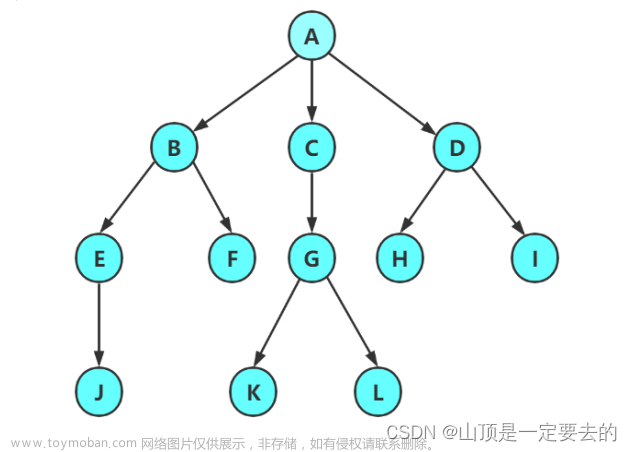目录
1. 题目1:检查两棵树是否相同
2. 题目2:判断一棵树是否为另一棵树的子树
3. 题目3:翻转二叉树
4. 题目4:判断一棵树是否为平衡二叉树
5. 题目5:判断一棵树是否为对称二叉树
6. 题目6:二叉树的层序遍历
7. 题目7:二叉树的遍历
8. 题目8:二叉树的最近公共祖先
9. 题目9:根据前序与中序遍历构造二叉树
10. 题目10:根据中序与后序遍历构造二叉树
11. 题目11:根据二叉树创建字符串
12. 题目12:非递归实现二叉树前序遍历
13. 题目13:非递归实现二叉树中序遍历
14. 题目14:非递归实现二叉树后序遍历
1. 题目1:检查两棵树是否相同
题目链接:100. 相同的树 - 力扣(LeetCode)
解题思路:递归思路:判断根节点是否相同,左子树是否相同,右子树是否相同;
相同判定有两方面:结构与数值;
代码:文章来源地址https://www.toymoban.com/news/detail-652281.html
class Solution {
public boolean isSameTree(TreeNode p, TreeNode q) {
// 两树均为空
if(p == null && q == null){
return true;
}
// 两树一空一非空
if((p == null && q != null)||(p != null && q == null)){
return false;
}
// 两树均不为空
// 两树根节点数据域值不同
if(p.val != q.val){
return false;
}
// 两树根节点数据域值相同
return isSameTree(p.left,q.left) && isSameTree(p.right, q.right);
}
}时间复杂度:O(min(m,n));其中mn分别为两棵树的结点数;
2. 题目2:判断一棵树是否为另一棵树的子树
题目链接:572. 另一棵树的子树 - 力扣(LeetCode)
解题思路:判断两棵树是否相同,递归判断一棵是否为另一棵的左子树,是否为其右子树;
代码:
class Solution {
public boolean isSameTree(TreeNode p, TreeNode q){
if(p == null && q == null){
return true;
}
if((p == null && q != null) || (p != null && q == null)){
return false;
}
if(p.val != q.val){
return false;
}
return isSameTree(p.left, q.left) && isSameTree(p.right, q.right);
}
public boolean isSubtree(TreeNode root, TreeNode subRoot) {
if(root == null || subRoot == null){
return false;
}
if(isSameTree(root, subRoot)){
return true;
}
if(isSubtree(root.left,subRoot)){
return true;
}
if(isSubtree(root.right, subRoot)){
return true;
}
return false;
}
}时间复杂度:O(s * t);
3. 题目3:翻转二叉树
题目链接:226. 翻转二叉树 - 力扣(LeetCode)
解题思路:在二叉树不为空时,将二叉树的左右子树交换,再递归交换左子树的左右子树和右子树的左右子树;
代码:
class Solution {
public TreeNode invertTree(TreeNode root) {
if(root == null){
return null;
}
TreeNode tmp = root.left;
root.left = root.right;
root.right = tmp;
invertTree(root.left);
invertTree(root.right);
return root;
}
}4. 题目4:判断一棵树是否为平衡二叉树
题目链接:110. 平衡二叉树 - 力扣(LeetCode)
解题思路:
代码1:
class Solution {
public boolean isBalanced(TreeNode root) {
if(root == null){
return true;
}
int leftH = maxDepth(root.left);
int rightH = maxDepth(root.right);
return Math.abs(leftH - rightH) <2
&& isBalanced(root.left)
&& isBalanced(root.right);
}
public int maxDepth(TreeNode root){
if(root == null){
return 0;
}
int leftHeight = maxDepth(root.left);
int rightHeight = maxDepth(root.right);
return (leftHeight>rightHeight)?(leftHeight+1):(rightHeight+1);
}
}时间复杂度:O(N²);
代码2:
class Solution {
public boolean isBalanced(TreeNode root) {
return maxDepth(root) >=0;
}
public int maxDepth(TreeNode root){
if(root == null){
return 0;
}
int leftHeight = maxDepth(root.left);
if(leftHeight < 0){
return -1;
}
int rightHeight = maxDepth(root.right);
if(rightHeight < 0){
return -1;
}
if(Math.abs(leftHeight - rightHeight) <= 1){
return Math.max(leftHeight,rightHeight)+1;
}else{
return -1;
}
}
}时间复杂度:O(N);
5. 题目5:判断一棵树是否为对称二叉树
题目链接:101. 对称二叉树 - 力扣(LeetCode)
代码:
class Solution {
public boolean isSymmetric(TreeNode root) {
if(root == null){
return true;
}
// 判断左子树的左树 和 右子树的右树是否对称
return isSymmetricChild(root.left,root.right);
}
public boolean isSymmetricChild(TreeNode leftTree, TreeNode rightTree){
if(leftTree == null && rightTree == null){
return true;
}
if((leftTree == null && rightTree != null)||
(leftTree != null && rightTree == null)){
return false;
}
// 左右子树均不为空
// 左右子树根节点数据不同
if(leftTree.val != rightTree.val){
return false;
}
// 左右子树根节点数据相同
return isSymmetricChild(leftTree.left,rightTree.right) &&
isSymmetricChild(leftTree.right, rightTree.left);
}
}6. 题目6:二叉树的层序遍历
题目链接:102. 二叉树的层序遍历 - 力扣(LeetCode)
代码:
class Solution {
public List<List<Integer>> levelOrder(TreeNode root) {
List<List<Integer>> list = new ArrayList<>();
if(root == null){
return list;
}
Queue<TreeNode> queue = new LinkedList<>();
queue.offer(root);
while(!queue.isEmpty()){
int size = queue.size();
List<Integer> tmp = new ArrayList<>();
while(size != 0){
TreeNode cur = queue.poll();
tmp.add(cur.val);
size--;
if(cur.left != null){
queue.offer(cur.left);
}
if(cur.right != null){
queue.offer(cur.right);
}
}
list.add(tmp);
}
return list;
}
}7. 题目7:二叉树的遍历
题目链接:二叉树遍历_牛客题霸_牛客网
代码:
import java.util.Scanner;
class TreeNode{
public char val;
public TreeNode left;
public TreeNode right;
public TreeNode(char val){
this.val = val;
}
}
// 注意类名必须为 Main, 不要有任何 package xxx 信息
public class Main {
public static void main(String[] args) {
Scanner in = new Scanner(System.in);
// 注意 hasNext 和 hasNextLine 的区别
while (in.hasNextLine()) { // 注意 while 处理多个 case
i=0; // 将i置为0,防止多组测试i累加
String str = in.nextLine();
TreeNode root = createTree(str);
inOrder(root);
}
}
public static int i = 0;
public static TreeNode createTree(String str){
TreeNode root = null;
if(str.charAt(i)!='#'){
// 遍历字符串,不为空的字符创建结点:
root = new TreeNode(str.charAt(i));
i++;
root.left = createTree(str);
root.right = createTree(str);
}else{
// 字符串遍历至#:
i++;
}
return root;
}
public static void inOrder(TreeNode root){
if(root == null){
return;
}
inOrder(root.left);
System.out.print(root.val+" ");
inOrder(root.right);
}
}8. 题目8:二叉树的最近公共祖先
题目链接:236. 二叉树的最近公共祖先 - 力扣(LeetCode)
解题思路:
方法1:除过空树与pq二者之一为根结点的情况外,分为三种情况:第一种:pq分别在根的左右两边;第二种:pq都在根的左边或右边;第三种:pq中有一个结点是公共祖先;
代码:
public TreeNode lowestCommonAncestor(TreeNode root, TreeNode p, TreeNode q){
if(root == null){
return null;
}
if(p == root || q == root){
return root;
}
// 分别在根结点的左右子树查找目标结点
TreeNode leftRet = lowestCommonAncestor(root.left, p, q);
TreeNode rightRet = lowestCommonAncestor(root.right, p, q);
// 第一种情况:左右子树均有目标结点则根结点为公共祖先
if(leftRet != null && rightRet != null){
return root;
}else if(leftRet != null){
// 第二种情况: 右子树没有查询到目标结点:两个目标结点均在左子树
return leftRet;
// leftRet已经记录了左子树查询到的第一个目标结点
// 同时由于2个目标结点均在左子树,即已经记录到的leftRet即是两个结点的最近公共祖先
}else if(rightRet != null){
// 左子树没有查询到目标结点:两个目标结点均在右子树
return rightRet;
// 同第一个else-if语句,rightRet即是2个目标结点的最近公共祖先
}
return null;
}方法2:建两个栈,分别存储pq两结点从根结点开始途径的每一个结点,从结点多的栈开始出栈,从两个栈元素数量相同开始,两个栈同时弹出栈顶元素进行比较是否相同,相同则是公共祖先,不相同则依次比较下一个元素;
代码:
class Solution {
public TreeNode lowestCommonAncestor(TreeNode root, TreeNode p, TreeNode q) {
// 建2个栈分别用于存放根结点root到目标结点p与q的路径结点
Deque<TreeNode> stack1 = new LinkedList<>();
getPath(root, p, stack1);
Deque<TreeNode> stack2 = new LinkedList<>();
getPath(root, q, stack2);
// 判断栈大小,先出栈元素多的栈直至与另一个栈元素个数相同,两栈开始同时出栈元素
int size1 = stack1.size();
int size2 = stack2.size();
if(size1> size2){
int size = size1 - size2;
while(size != 0){
stack1.pop();
size--;
}
}else{
int size = size2 - size1;
while(size != 0){
stack2.pop();
size--;
}
}
// 此时两栈元素个数已经相同
// 当两个栈均不为空时,逐个元素对比
while(!stack1.isEmpty() && !stack2.isEmpty()){
// 两栈栈顶元素不同则同时出栈
if(stack1.peek() != stack2.peek()){
stack1.pop();
stack2.pop();
}else{
// 两栈栈顶元素相同:该结点为公共祖先
return stack1.peek();
}
}
return null;
}
public boolean getPath(TreeNode root, TreeNode node, Deque<TreeNode> stack){
// 查找从根结点root到目标结点node路径上的结点并存放到栈stack中
if(root == null || node == null){
return false;
}
// 将当前结点入栈
stack.push(root);
// 判断该结点是否为目标结点
if(root == node){
return true;
}
// 判断该结点左子树中是否有目标结点
boolean ret1 = getPath(root.left, node, stack);
if(ret1 == true){
return true;
}
// 判断该结点右子树中是否有目标结点
boolean ret2 = getPath(root.right, node, stack);
if(ret2 == true){
return true;
}
// 左右子树均查询无果,则出栈该结点并返回空
stack.pop();
return false;
}
}注:如果二叉树每个结点中存储了其父亲结点的地址,则改题等效于求两个链表的交叉结点问题;
9. 题目9:根据前序与中序遍历构造二叉树
题目链接:105. 从前序与中序遍历序列构造二叉树 - 力扣(LeetCode)
代码:
class Solution {
public int i=0; //用于前序preorder遍历
public TreeNode buildTree(int[] preorder, int[] inorder) {
return buildTreeChild(preorder, inorder, 0,inorder.length-1);
}
public TreeNode buildTreeChild(int[] preorder, int[] inorder, int inBgein, int inEnd){
if(inBgein > inEnd){ // 没有子树
return null;
}
TreeNode root = new TreeNode(preorder[i]); // root结点
// 在中序遍历inorder中定位根结点root位置
int rootIndex = findIndex(inorder, inBgein, inEnd, preorder[i]);
i++;
// 在中序遍历中确定根结点位置后,其左为左树,右为右树
root.left = buildTreeChild(preorder, inorder, inBgein, rootIndex-1);
root.right = buildTreeChild(preorder, inorder, rootIndex+1, inEnd);
return root;
}
private int findIndex(int[] inorder, int inBgein, int inEnd, int key){
for(int i=inBgein; i<= inEnd;i++){
if(inorder[i] == key){
return i;
}
}
return -1;
}
}10. 题目10:根据中序与后序遍历构造二叉树
题目链接:106. 从中序与后序遍历序列构造二叉树 - 力扣(LeetCode)
代码:
class Solution {
public int i =0;
public TreeNode buildTree(int[] inorder, int[] postorder) {
i = inorder.length-1;
return buildTreeChild(postorder, inorder, 0, inorder.length-1);
}
public TreeNode buildTreeChild(int[] postorder, int[] inorder, int inBegin, int inEnd){
if(inBegin > inEnd){
return null;
}
TreeNode root = new TreeNode(postorder[i]);
int rootIndex = findIndex(inorder, inBegin, inEnd, postorder[i]);
i--;
root.right = buildTreeChild(postorder, inorder, rootIndex+1, inEnd);
root.left = buildTreeChild(postorder, inorder, inBegin, rootIndex-1);
return root;
}
private int findIndex(int[] inorder, int inBegin, int inEnd, int key){
for(int j=inBegin;j<=inEnd;j++){
if(inorder[j] == key){
return j;
}
}
return -1;
}
}11. 题目11:根据二叉树创建字符串
题目链接:606. 根据二叉树创建字符串 - 力扣(LeetCode)
解题思路:分为以下三种情况:(1)结点左右均为空:直接返回;(2)结点左不为空右为空:无需为空结点增加括号;(3)结点左空右不为空,给空结点增加括号;
代码:
class Solution {
public String tree2str(TreeNode root) {
if(root == null){
return null;
}
StringBuilder stringBuilder = new StringBuilder();
tree2strChild(root, stringBuilder);
return stringBuilder.toString();
}
public void tree2strChild(TreeNode node, StringBuilder stringBuilder){
if(node == null){
return;
}
stringBuilder.append(node.val);
// 判断结点左子树
if(node.left != null){
// 结点左孩子不为空
stringBuilder.append("(");
tree2strChild(node.left, stringBuilder);
stringBuilder.append(")");
}else{
// 结点左孩子为空
// 情况1:结点右孩子不为空
if(node.right != null){
stringBuilder.append("()");
}else{
// 情况2:结点右孩子为空
return;
}
}
// 判断结点右子树
if(node.right == null){
// 结点右孩子为空:直接返回
return;
}else{
// 结点右孩子不为空:递归结点的右子树
stringBuilder.append("(");
tree2strChild(node.right, stringBuilder);
stringBuilder.append(")");
}
}
}12. 题目12:非递归实现二叉树前序遍历
题目链接:144. 二叉树的前序遍历 - 力扣(LeetCode)
代码:
class Solution {
public List<Integer> preorderTraversal(TreeNode root) {
List<Integer> ret = new ArrayList<>();
if(root == null){
return ret;
}
TreeNode cur = root; // 用于遍历二叉树
Deque<TreeNode> stack = new ArrayDeque<>();
while(cur != null || !stack.isEmpty()){
while(cur != null){
stack.push(cur);
ret.add(cur.val);
cur = cur.left;
}
TreeNode top = stack.pop();
cur = top.right;
}
return ret;
}
}13. 题目13:非递归实现二叉树中序遍历
题目链接:94. 二叉树的中序遍历 - 力扣(LeetCode)
代码:
class Solution {
public List<Integer> inorderTraversal(TreeNode root) {
List<Integer> ret = new ArrayList<>();
if(root == null){
return ret;
}
TreeNode cur = root;
Deque<TreeNode> stack = new ArrayDeque<>();
while(cur != null || !stack.isEmpty()){
while(cur != null){
stack.push(cur);
cur = cur.left;
}
TreeNode top = stack.pop();
ret.add(top.val);
cur = top.right;
}
return ret;
}
}14. 题目14:非递归实现二叉树后序遍历
题目链接:145. 二叉树的后序遍历 - 力扣(LeetCode)文章来源:https://www.toymoban.com/news/detail-652281.html
代码:
class Solution {
public List<Integer> postorderTraversal(TreeNode root) {
List<Integer> ret = new ArrayList<>();
if(root == null){
return ret;
}
TreeNode cur = root;
TreeNode prev = null;
Deque<TreeNode> stack = new ArrayDeque<>();
while(cur != null || !stack.isEmpty()){
while(cur != null){
stack.push(cur);
cur = cur.left;
}
// 后序遍历顺序为:根->左->右
TreeNode top = stack.peek(); // 不可以直接pop栈顶元素
// 当栈顶元素结点没有右子树时才可以打印根结点
if(top.right == null || top.right == prev){
ret.add(top.val);
stack.pop();
prev = top;
}else{
// 栈顶元素结点有右子树,优先遍历右子树后再打印根结点
cur = top.right;
}
}
return ret;
}
}到了这里,关于【数据结构】_8.二叉树OJ的文章就介绍完了。如果您还想了解更多内容,请在右上角搜索TOY模板网以前的文章或继续浏览下面的相关文章,希望大家以后多多支持TOY模板网!














